Publications
| Summary of Publication | Publication Preview |
|---|---|
Walking on Real Numbers - CORE PUBLICATION(Math. Intelligencer 35 (1) (July 2013), 42—60) This is the core publication of our research into real numbers. |
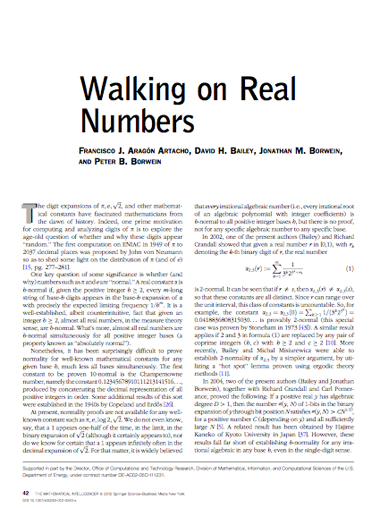 |
Normal Numbers and Normality Measure(Combinatorics, Probability and Computing 22 (3) (May 2013), 342—345) In a paper published in this journal, Alon, Kohayakawa, Mauduit, Moreira and Rödl proved that the minimal possible value of the normality measure of an N-element binary sequence satisfies |
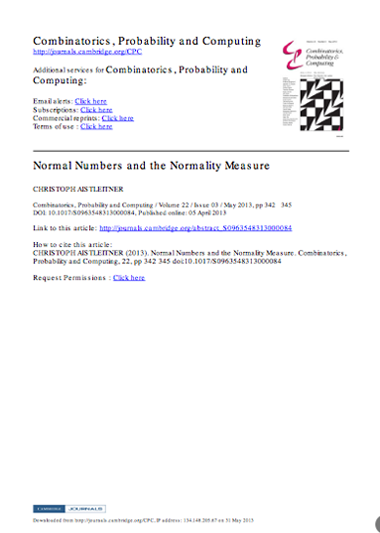 |
Mahler measures, short walks and log-sine integrals(Theoretical Computer Science 479 (1) (April 2013), 4–21) The Mahler measure of a polynomial in several variables has been a subject of much study over the past thirty years — very few closed forms are proven but more are conjectured. In the case of multiple Mahler measures more tractable but interesting families exist. Using values of log-sine integrals we provide systematic evaluations of various higher and multiple Mahler measures.
|
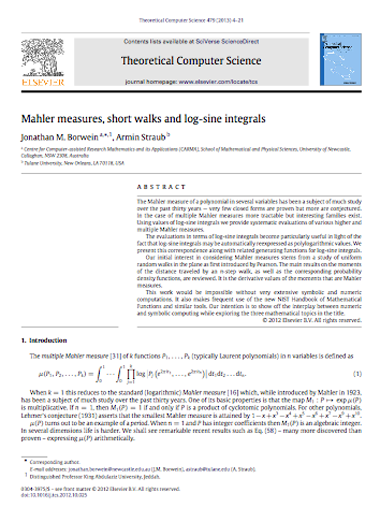 |
Closed Forms: What They Are and Why We Care(Notices of the AMS 60 (1) (January 2013), 50—65) Mathematics abounds in terms that are in frequent use yet are rarely made precise. Two such are rigorous proof and closed form (absent the technical use within differential algebra). If a rigorous proof is “that which ‘convinces’ the appropriate audience,” then a closed form is “that which looks ‘fundamental’ to the requisite consumer.” In both cases, this is a community-varying and epoch-dependent notion. What was a compelling proof in 1810 may well not be now; what is a fine closed form in 2010 may have been anathema a century ago. In this article we are intentionally informal as befits a topic that intrinsically has no one “right” answer. Let us begin by sampling the Web for various approaches to informal definitions of “closed form”. |
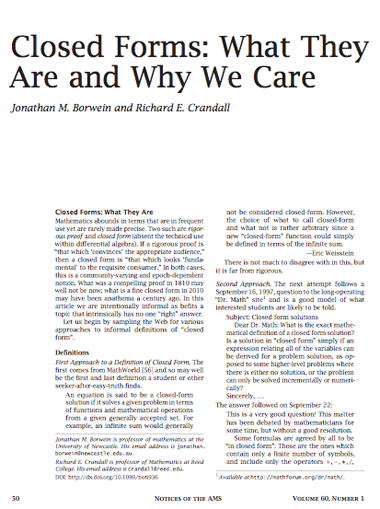 |
Être normal? Pas si facile!(Pour la Science 422 (December 2012)) In 1908, the French mathematician Émile Borel (1871-1956) queries on particular properties that may have the usual numbers decimal, such as √2, e or π. He introduced the concept of "normal number" which we will discuss below the definition. |
 |
The Life of Pi(Prepared for Berggren Festschrift, Draft VIII. 19/06/2012) The desire to understand π the challenge, and originally the need, to calculate ever more accurate values of π the ratio of the circumference of a circle to its diameter, has challenged mathematicians–great and less great — for many centuries. It has also, especially recently, provided compelling examples of computational mathematics. π uniquely in mathematics, is pervasive in popular culture and the popular imagination. |
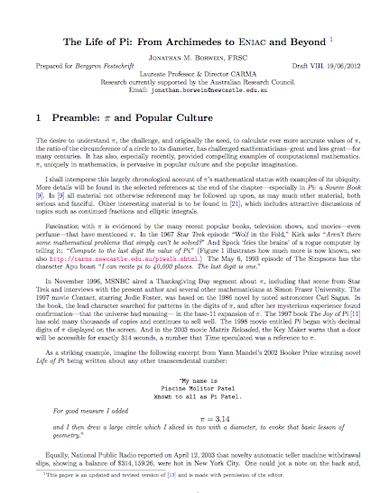 |
Abnormality of Stoneham Numbers(The Ramanujan Journal 29 (1-3) (June 2012), 409-422) This paper examines “Stoneham constants,” namely real numbers of the form α b,c=∑ n≥11/(c nb c n) , for coprime integers b≥2 and c≥2. These are of interest because, according to previous studies, α b,c is known to be b-normal, meaning that every m-long string of base-b digits appears in the base-b expansion of the constant with precisely the limiting frequency b −m .
|
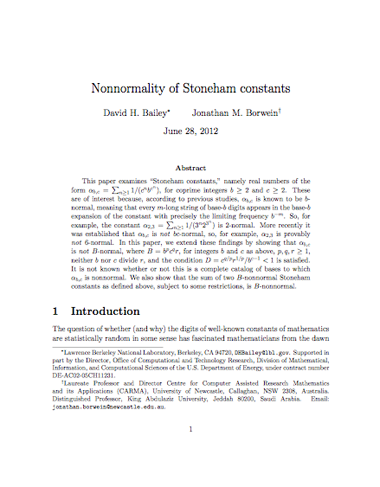 |
Proof of some Conjectured Formulas for π(Journal of Mathematical Physics 53 (7) (May 2012)) In a recent study of representing Dirac's delta distribution using q-exponentials, M. Jauregui and C. Tsallis experimentally discovered formulae for π as hyper-geometric series as well as certain integrals. Herein, we offer rigorous proofs of these identities using various methods and our primary intent is to lay down an illustration of the many technical underpinnings of such evaluations.
|
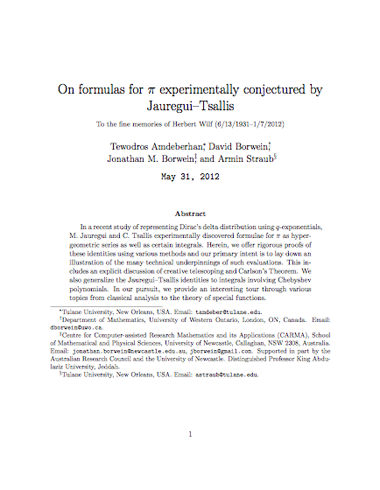 |
Ramanujan and π(May 2012) This contribution highlights the progress made regarding Ramanujan's work on Pi since the centennial of his birth in 1987. |
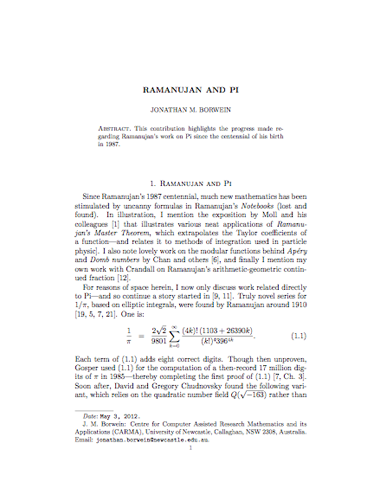 |
The art of π, φ and e(mkweb.bcgsc.ca (April 2012)) Numerology is bogus, but art based on numbers has a beautiful random quality. A visually beautiful article. |
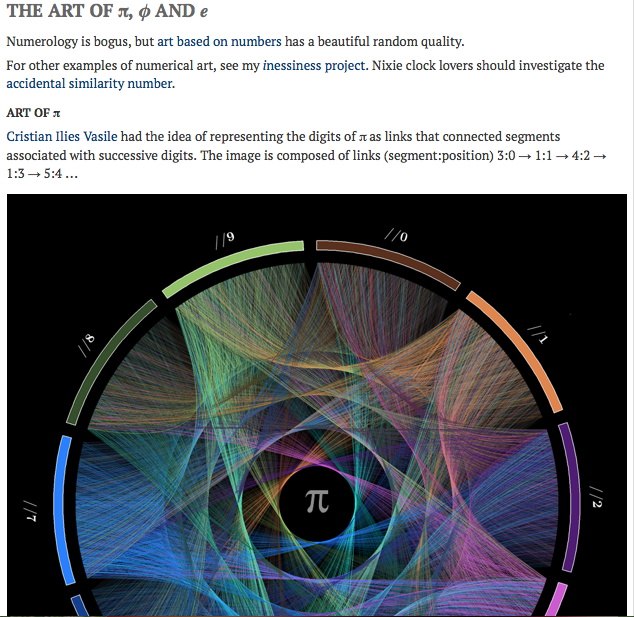 |
On the Normality of Pi(Experimental Mathematics 21 (4) (February 2012), 375—384) Using the results of several extremely large recent computations, we tested positively the normality of a prefix of roughly four trillion hexadecimal digits of π.. This result was used by a Poisson process model of normality of π.: in this model, it is extraordinarily unlikely that π. is not asymptotically normal base 16, given the normality of its initial segment. |
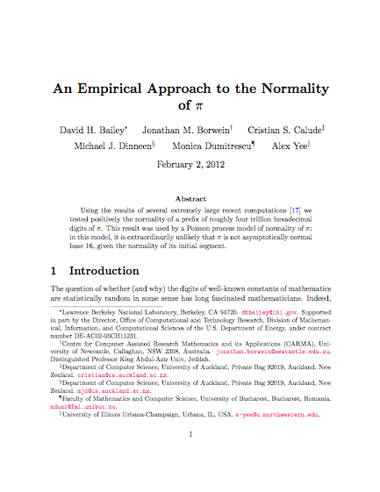 |
Mahler measures, short walks and log-sine integrals(January 2012) The Mahler measure of a polynomial in several variables has been a subject of much study over the past thirty years — very few closed forms are proven but more are conjectured. In the case of multiple Mahler measures more tractable but interesting families exist. Using values of log-sine integrals we provide systematic evaluations of various higher and multiple Mahler measures.
|
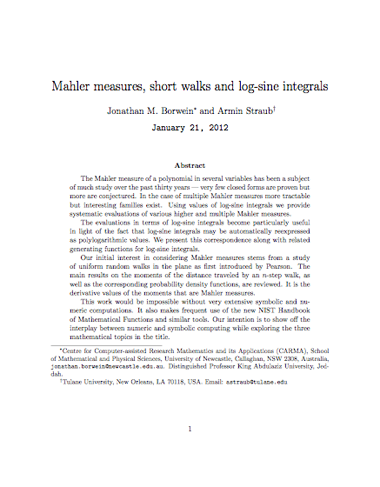 |
Measures of Pseudorandomness for Finite Sequences: Minimal Values(Combinatorics, Probability and Computing 15 (1-2) (January 2006), 1—29) Mauduit and Sárközy introduced and studied certain numerical parameters associated to finite binary sequences EN ∈ {−1, 1} N in order to measure their ‘level of randomness’. Those parameters, the normality measure N (EN), the well-distribution measure W (EN), and the correlation measure Ck(EN) of order k, focus on different combinatorial aspects of EN.
|
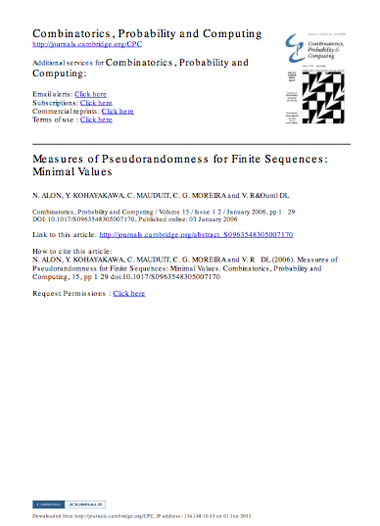 |